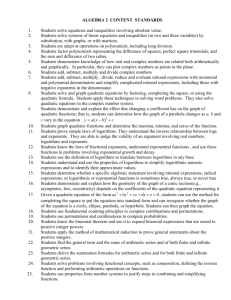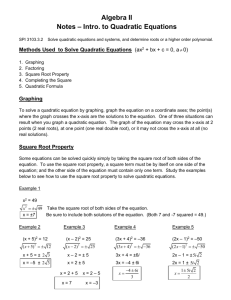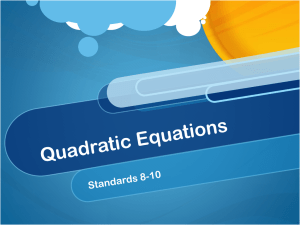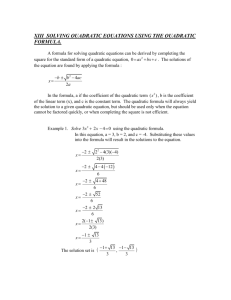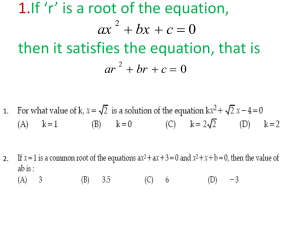Algebra I Unit 4 - Livingston County School District
advertisement
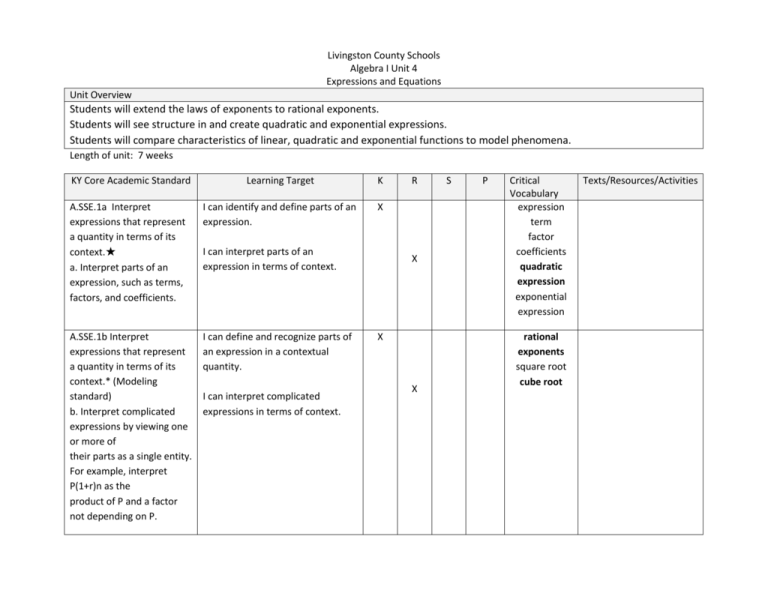
Livingston County Schools Algebra I Unit 4 Expressions and Equations Unit Overview Students will extend the laws of exponents to rational exponents. Students will see structure in and create quadratic and exponential expressions. Students will compare characteristics of linear, quadratic and exponential functions to model phenomena. Length of unit: 7 weeks KY Core Academic Standard Learning Target K A.SSE.1a Interpret expressions that represent a quantity in terms of its context.★ a. Interpret parts of an expression, such as terms, factors, and coefficients. I can identify and define parts of an expression. X A.SSE.1b Interpret expressions that represent a quantity in terms of its context.* (Modeling standard) b. Interpret complicated expressions by viewing one or more of their parts as a single entity. For example, interpret P(1+r)n as the product of P and a factor not depending on P. I can define and recognize parts of an expression in a contextual quantity. I can interpret parts of an expression in terms of context. I can interpret complicated expressions in terms of context. R X X X S P Critical Vocabulary expression term factor coefficients quadratic expression exponential expression rational exponents square root cube root Texts/Resources/Activities A.SSE.2 Use the structure of an expression to identify ways to rewrite it. For example, see x4 – y4 as (x2)2 – (y2)2, thus recognizing it as a difference of squares that can be factored as (x2 – y2)(x2 + y2). I can identify ways to rewrite expressions. I can identify various structures of expressions. X X I can use the structure of an expression to identify ways to rewrite it. X I can classify expressions by structure. X A.SSE.3a Choose and produce an equivalent form of an expression to reveal and explain properties of the quantity represented by the expression.★ a. Factor a quadratic expression to reveal the zeros of the function it defines. I can factor a quadratic expression. X I can explain the connection between the factored form and the zeros of the function. X I can explain the properties of the quantity represented by the quadratic expression. X A.SSE.3b Choose and produce an equivalent form of an expression to reveal and explain properties of the quantity represented by I can complete the square. quadratic expression zeros X I can choose and produce an equivalent form of a quadratic expression. I can explain the connection between the completed square form and the maximum or difference of squares factoring regrouping scalar X complete the square X maximum the expression.* (Modeling standard) b. Complete the square in a quadratic expression to reveal the maximum or minimum value of the function it defines. minimum value. A.SSE.3c Choose and produce an equivalent form of an expression to reveal and explain properties of the quantity represented by the expression.* (*Modeling standard) c. Use the properties of exponents to transform expressions for exponential functions. For example the expression 1.15t can be rewritten as (1.151/12)12t ≈ 1.01212t to reveal the approximate equivalent monthly interest rate if the annual rate is 15%. I can complete the square. X I can explain the connection between the completed square form and the maximum or minimum value. X I can explain the properties of the quantity represented by the expression. X A.APR.1 Understand that polynomials form a system analogous to the integers, namely, they are closed under the operations I can identify that the sum, difference or product of two polynomials will always be a polynomial. minimum I can explain the properties of the quantity represented by the expression. X I can choose and produce an equivalent form of a quadratic expression. X complete the square maximum I can choose and produce an equivalent form of a quadratic expression. minimum X X polynomial closure of addition, subtraction, and multiplication; add, subtract, and multiply polynomials. I can define "closure." X I can apply arithmetic operations to polynomials. X A.CED.1 Create equations and inequalities in one variable and use them to solve problems. Include equations arising from linear and quadratic functions, and simple rational and exponential functions. I can solve one variable linear and exponential equations. X quadratic equations I can solve one variable inequalities. X solve I can solve quadratic equations. X I can describe and express the relationships between the quantities in the problem. X A.CED.2 Create equations in two or more variables to represent I can create and use equations and inequalities in one variable to solve problems. X I can create equations and inequalities in one variable to model real-world situations. X I can compare/contrast problems that can be solved by different types of equations. X I can identify and describe the quantities represented by distinct variables in real-world situations. X distinct variables dependent relationships between quantities; graph equations on coordinate axes with labels and scales. independent I can graph one or more equation on a coordinate axes. X I can create at least two equations in two or more variables to represent relationships. X I can justify which quantities in a real-world situation are dependent and independent. X I can determine appropriate units for the labels/scale of a graph. X A.CED.4 Rearrange formulas to highlight a quantity of interest, using the same reasoning as in solving equations. For example, rearrange Ohm’s law V = IR to highlight resistance R. I can define a quantity of interest. A.REI.4a Solve quadratic equations in one variable. a. Use the method of completing the square to transform any quadratic equation in x into an equation of the form (x – p)2 = q that has the same solutions. I can complete the square to transform any quadratic equation. X X I can solve a formula for a given variable. I can solve quadratic equations in one variable. quantity of interest literal equations X complete the square X complex number I can derive the quadratic formula. X I can solve quadratic equations. X quadratic Derive the quadratic formula from this form. b. Solve quadratic equations by inspection (e.g., for x2 = 49), taking square roots, completing the square, the quadratic formula and factoring, as appropriate to the initial form of the equation. Recognize when the quadratic formula gives complex solutions and write them as a ± bi for real numbers a and b. A.REI.7 Solve a simple system consisting of a linear equation and a quadratic equation in two variables algebraically and graphically. For example, find the points of intersection between the line y = –3x and the circle x2 + y2 = 3. Spiraled Standards: formula X I can express complex solutions. square roots I can determine appropriate strategies to solve quadratic equations. X factoring I can recognize when the quadratic formula gives complex solutions. I can transform a simple system consisting of a linear equation and a quadratic equation in 2 variables so that a solution can be found algebraically and graphically. I can explain the correspondence between the algebraic and graphical solutions. X X complex solution linear equation quadratic equation X HOT Questions:
